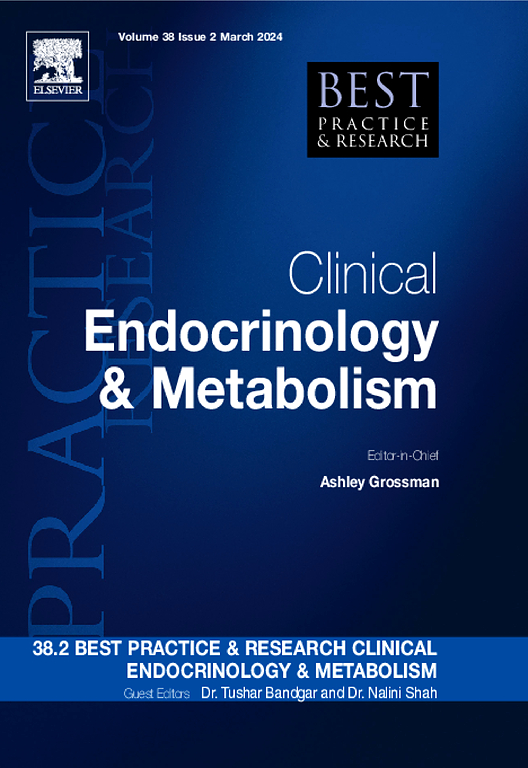头颈部副神经节瘤:转化和临床研究的最新进展以及患者护理指南。
IF 6.1
1区 医学
Q1 ENDOCRINOLOGY & METABOLISM
Best practice & research. Clinical endocrinology & metabolism
Pub Date : 2024-12-01
DOI:10.1016/j.beem.2024.101951
引用次数: 0
摘要
头颈部副神经节瘤(HNPGLs)是一种罕见的神经内分泌肿瘤,主要产生于颅神经的副交感神经节,由于其解剖学起源、侵袭性神经血管和颅底浸润倾向、不可预测的转移潜力、放射化疗耐药性和多发性风险,该肿瘤具有挑战性。症状从轻微到危及生命不等,视部位/大小而定,但很少与儿茶酚胺过多有关。风险因素包括女性性别和影响缺氧信号转导基因(最重要的是琥珀酸脱氢酶基因)的致病性种系变异。诊断工作依赖于影像学、血浆游离甲氧基肾上腺素/甲氧基酪胺的测量、基因检测和病理学/免疫组化。治疗方法根据患者/肿瘤的特点而定,包括等待扫描、前期手术、切除手术和放疗。建议进行术前栓塞,但小的鼓室和鼓室样肿瘤除外。颈内动脉受累时需要进行术前支架植入,硬膜内扩展时需要进行两期手术。目前针对转移性/无法手术的 HNPGL 的治疗都是非根治性的,建议对所有患者进行长期随访,以监测局部复发和新肿瘤的情况。本文章由计算机程序翻译,如有差异,请以英文原文为准。
Head and neck paragangliomas: Recent advances in translational and clinical research and guidelines for patient care
Head and neck paragangliomas (HNPGLs), rare neuroendocrine tumors that mainly arise from parasympathetic ganglia along the cranial nerves, are challenging due to anatomic origin, tendency to aggressive neurovascular and skull base infiltration, unpredictable metastatic potential, radio-chemoresistance, and risk of multiplicity. Symptoms range from mild to life threatening depending on location/size, but rarely relate to catecholamine excess. Risk factors include female sex and pathogenic germline variants in genes affecting hypoxia signaling (foremost succinate dehydrogenase genes). Diagnostic work-up relies on imaging, measurements of plasma free metanephrines/methoxytyramine, genetic testing, and pathology/immunohistochemistry. Management is tailored to patient/tumor characteristics and encompasses wait-scan, upfront surgery, debulking surgery, and radiotherapy. Presurgical embolization is recommended, except for small tympanic and tympanomastoid tumors. Presurgical stenting is required for internal carotid artery involvement, and two-stage surgery for intradural extension. Current treatments for metastatic/inoperable HNPGL are non-curative, and long-term follow-up should be recommended for all patients to monitor local recurrence and new tumors.
求助全文
通过发布文献求助,成功后即可免费获取论文全文。
去求助
来源期刊
CiteScore
11.90
自引率
0.00%
发文量
77
审稿时长
6-12 weeks
期刊介绍:
Best Practice & Research Clinical Endocrinology & Metabolism is a serial publication that integrates the latest original research findings into evidence-based review articles. These articles aim to address key clinical issues related to diagnosis, treatment, and patient management.
Each issue adopts a problem-oriented approach, focusing on key questions and clearly outlining what is known while identifying areas for future research. Practical management strategies are described to facilitate application to individual patients. The series targets physicians in practice or training.

 求助内容:
求助内容: 应助结果提醒方式:
应助结果提醒方式:


